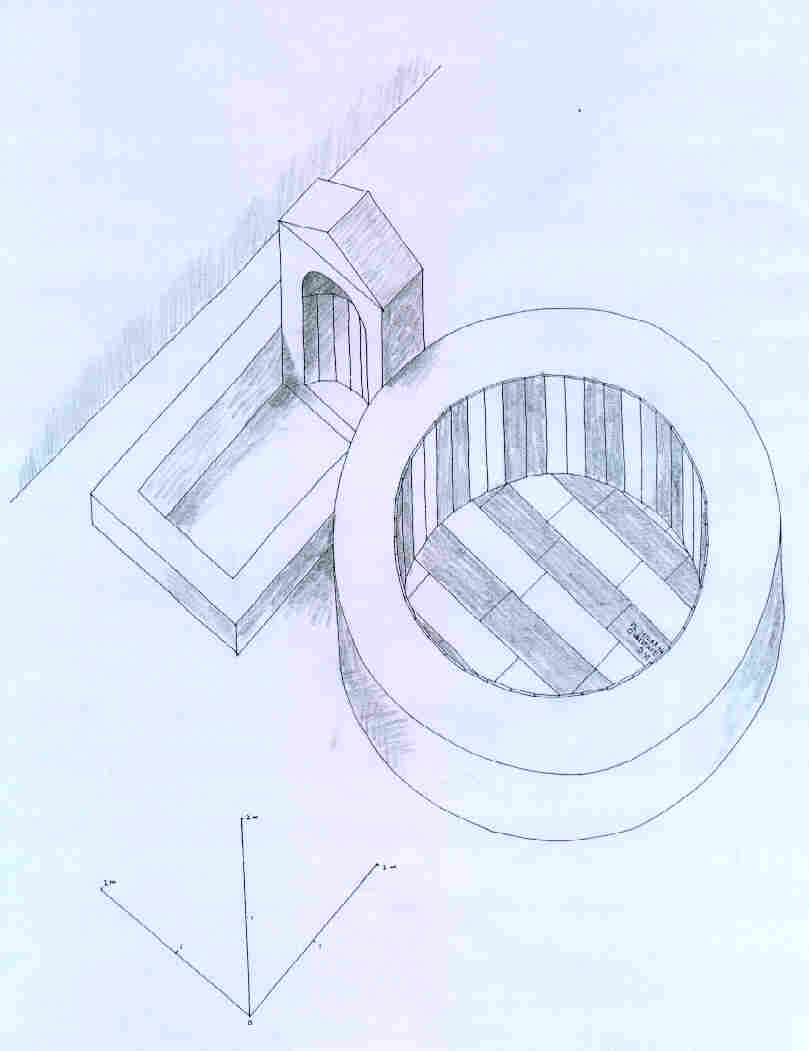Swedish Research in
San Lorenzo in Lucina
(Rome)
- The Transformationsof a Late Antique
Roman Quarter
ROMAN AND
EARLY CHRISTIAN
PHASES
Made by: Olof Brandt
Swedish Institute in Rome
Web page:
http://www.svenska-institutet-rom.org
Via Omero 14
I-00197 Rome, Italy
E-mail: isvroma@vatlib.it
| AN EARLY CHRISTIAN BAPTISTERY | The baptistery |
| Early Christian baptisteries | Early christian texts about baptism |
| The washing of feet after baptism | Ambrose writes about feet washing |
A 4th century basin for ritual feet washing?
| A mysterious basin
To the east of the circular font,
there is a badly damaged rectangular basin, which measures about 2,2 x
1,35 m. On the south short side, there is a kind of nich with the bottom
15 cms above the bottom of the rectangular basin. What was its original
shape? Perhaps one can compare with some earlier Roman nymphaea from Pompeji
with a kind of aedicula with a nich in front of a low basin, and reconstruct
the two basins as in this drawing.
The secondary, rectangular basin may have been used for the washing of feet, imitating what Jesus did to the Apostles in John 13. On this page, some of the evidence for this rite will be discussed. Some sources mention this rite as
a part of baptism after immersion and anointing. St. Ambrose in Milan wrote
in 380-390 that this part of the rite had been left out in Rome. For
this reason, the secondary basin in San Lorenzo in Lucina could be used
for the washing of feet only if the baptistery was built some time before
Ambrose wrote, in the mid fourth century.
The fourth century was a period when the washing of the feet was left out not only in Rome but also in Spain. Already in 305, the council of Elvira states in its canon 48 that the rite should be abrogated.
Usually, the church and the baptistery have been dated to 432-440 through the identification with a church built to honor the Roman martyr Laurentius (Lawrence). The washing of feet was never reintroduced in Rome, so a 5th c basin for feet washing in Rome would be impossible. However, we may have to consider the possibility that the church and the baptistery may be older, from the middle of the 4th c. The main difficulty of this interpretation of the secondary basin is chronological: most scholars have dated the basilica, and thus the baptistery, to the fifth and not the fourth century. The advantage is that this
interpretation could explain why similar secondary basins generally are
not found in other baptisteries in the Roman parishes (tituli), which
usually are dated after the fourth century. Any other interpretation of
the basin must also explain why similar basins are not found elsewhere
in Rome.
|
Many thanks to Pavel L. Gavrilyuk, Perkins School of Theology, Southern Methodist University (Dallas, Texas), for stimulating discussions about the prohibition of foot washing in the fourth century.
